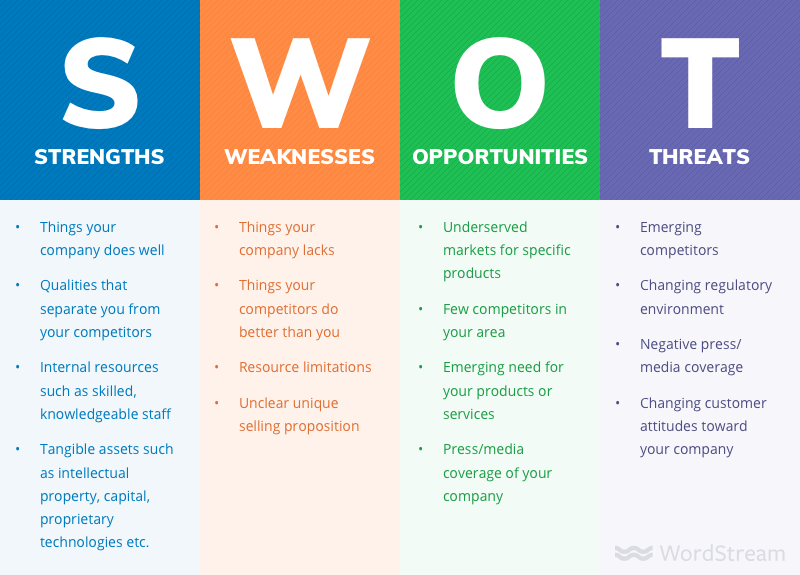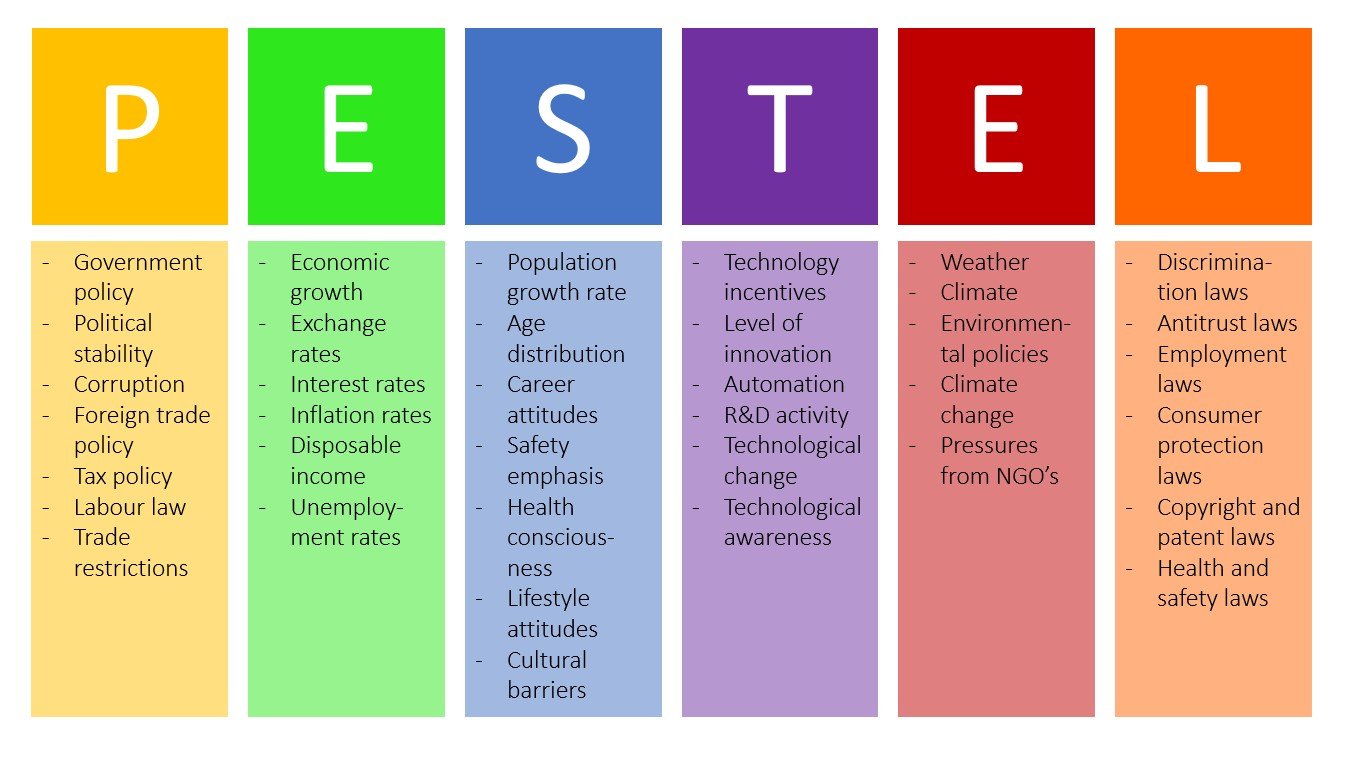A good SWOT, (Aka, strengths, weakness, opportunities, and threats) analysis is an essential part of any marketing project. Using this platform, students can identify the key focus areas for their research.
However, SWOT analysis is not a fool-proof methodology. Students are prone to make few fundamental errors which can hamper their research. I have listed down the top 18 mistakes you should look out for.

Not being holistic with your data.
SWOT analysis is a macro analysis approach that gives you a vague idea about the market. Using this, the company can understand the basic situation of the industry. It also outlines the internal position of the company.
And while SWOT provides a good Segway, you cannot wholly rely on it for a holistic picture. Students often face some discrepancies in the data collection and sorting process. An excellent way to resolve this issue would be to rely on credible data analysis platforms.
Being subjective
Research is an objective process where the personal opinions of the researcher should ideally have no place. The same rules apply for SWOT analysis as well. The marketing students cannot let their personal opinions dictate their study.
So, when you are writing a SWOT report, do not use first or second-person pronouns. Instead, stick to professional language, which is impersonal and research-oriented. The reason for this being personal bias often clouds our estimation of data.
SWOT analysis mistakes you can’t ignore
Incomplete or distorted information
The information collected from market research and surveys is often in raw form. This information would make no sense to the user unless arranged in a logical order. However, students sometimes let their personal bias get the better of their judgement
The sources you pick this information from is also quite important. Ensure that you check the credibility of the marketing report or survey before borrowing from it. Frequently, the company has some vested interests in the study and might distort the data as per their convenience.
Unfocused approach
A common mistake that I find most students fall prey to is being unfocused. Data collection, distribution and sorting, can make or break your SWOT analysis. You need to gather some in-depth insights on the strengths and weaknesses to come to a proper conclusion.
Always keep the targets in mind when analyzing data for the SWOT analysis. Every marketing project has some specific goal or plan. As a marketing student, you learn how to focus on the critical aspects of the data to get the desired results.

Wrong placement
One of the most common errors that I find is when students place the wrong elements in the wrong place. There are four main aspects to a SWOT analysis where you can categorize information.
- Strengths
- Weakness
- Opportunities
- Threats
Once you have all the data, you need to arrange it in a vertical tabular form. The strengths and weaknesses are internal factors, i.e. which the company can control. Opportunities and threats are external factors you cannot ascertain.
Double entries
Students can get very careless when sorting the data into these four main categories. A common mistake that people make is entering the same element into different sections of the SWOT table. For instance, a probable threat might also be seen as a weakness for the firm
However, one must understand the subtle differences and arrange data accordingly. A threat is external, assumed, and future risk. The drawback is often an in-house matter.
Being unrealistic
SWOT analysis deals more with assumed information than concrete data. The user makes an estimation of the strengths, weaknesses, and other aspects of the company. These predictions are based on studying patterns and customer preferences.
Collecting data is a very scientific process. However, there may be times when you set unrealistic expectations from the analysis. As students, you need to be realistic, relevant, and credible in your approach.
Not setting a timeframe.
Almost every SWOT analysis study is conducted in a specific time frame. The data collected over the surveys also belong to a particular location and duration. These aspects play a pivotal role in generating accurate SWOT reports
Not having a timeframe can discredit your research. It makes your study inaccurate. The next time try setting some context into your research to make it realistic.
Lack of qualitative benchmarks
Every SWOT analysis requires some benchmarks to measure how well your estimation ranks up. With these benchmarks to compare to, you can predict the trends, risks, and profits of the firm more accurately.
A SWOT analysis requires a qualitative and quantitative approach. Students often get vast volumes of data but fail to check the quality of the information collected.

Inaccurate goal estimation
The strengths and opportunities depend on how precisely the student predicts the goals of the company. In fact, plans are fundamental to every SWOT analysis. You need to state your objectives clearly before diving down to the actual research.
However, most students thoroughly brush over this process. Note that this doesn’t save you any time and leads to more last-minute delays.
Overestimation of strengths
Often, the aspects you see as strengths for a company may not be as effective. Overestimating the strong points of the market is a general mistake you are prone to. Consult your peers and professors to gauge the accurate potential of strength.
Remember, accuracy comes with ample practice. You cannot expect to nail the SWOT report in the first try. Keep some room for errors.
SWOT analysis mistakes you can’t ignore
Undermining the weak aspects
Just as you overestimate the strengths, you can undermine the weaknesses. This means that you consider the weak aspects of the SWOT report not important enough. It can lead to some severe troubles as you don’t prepare well for contingencies
The weaknesses in the SWOT report help calculate losses for the firm. An inaccurate representation of these risks can cost the company heavily.
Generalizing factors
SWOT analysis is quite general, but that doesn’t mean you end up generalizing the strengths and weaknesses. Every report deals with a different company, sector, or marker-base. The physical location, internal management and future trends are the core pillars for your research.
Taking a generalized approach to SWOT reports can lead to data inconsistencies and mistakes. It is easier to form a different plan from scratch for every SWOT report.

Lack of clarity
It is always better to set your goals for the SWOT report beforehand. Few companies discourage market professionals from highlighting their vulnerabilities. They may not reveal certain aspects of their firm, leading to contradictions
Students need to set clear-cut objectives for every market report they generate. It saves you a lot of time and trouble. Devote a section to list down your expectations from the SWOT report. This gives you a perspective and reduces the risk of your research going astray.
Lack of in-depth analysis
Every SWOT report must end with a section stating the sources for your analysis. The reader can refer to these sources and judge the credibility of your research.
I suggest students use APA or Harvard style referencing for all their citations. Add a short bibliography towards the end to acknowledge the marketing theories, journals and papers used for your research.
Not customizing data
Every SWOT analysis must be treated as a separate entity. Of course, there are tendencies and patterns that you can draw inspiration from. However, don’t let the law of average cloud your judgement
Learn to adapt to the market situation. The more SWOT reports you to analyze, the better you learn to customize the data to your requirement.
Being contradictory
Sorting the data into either of the four categories is not a black and white process. You need to use your discretion at every step. Which aspects of the study are strengths? What are the vulnerable spots in your business? These are some core questions you need to consider.
Also, note that there may be certain discrepancies in the data. You may find the SWOT report contradictory and not have a definitive conclusion.
Ignoring PESTEL analysis
SWOT reports are not the be-all and end-all of market research. SWOT analysis is but the first step to thorough market research. You must also check out other mediums and tools to confirm the information used in the study.
A comprehensive reading of an industry’s strengths, weaknesses, opportunities, and threats is helpful to get a holistic picture. PESTEL analysis, for instance, gives you great insights into the micro-aspects of market study.
SWOT analysis for beginners
SWOT analysis is a platform that allows students to look into the internal and external aspects of a company. The strengths and weaknesses of the entity are internal factors. Opportunities and threats make up the external aspects
An accurate reading of all these factors makes up the complete picture. A marketing student can study these details, compare it, and understand where a company stands. It is also useful to estimate the scope and growth of the company in the future years.
Quick links for your reference
SWOT analysis guidelines: SWOT analysis guidelines by Queensland Govt.
Case study and SWOT mistakes: SWOT analysis errors in Healthcare institutions
Citation guidelines: Harvard referencing guide
Citation Generator: CiteFast
Image: screenshot
The bottom line
I hope that this blog helps you identify some of the common mistakes in SWOT analysis and avoid them for your future projects. Good luck!
SWOT analysis mistakes you can’t ignore


 WhatsApp Us
WhatsApp Us